The Resource Dilemma
Resources, resources, resources! It always feels like we need more: more books, more guidance, more authentic texts, more manipulatives. Once in a blue moon, a district has the funds to adopt new resources. Teachers cheer, “Woohoo!” Classrooms get filled with boxes upon boxes of this new resource, and we spend many hours figuring out how to store all of these new materials. And then the daunting task follows…
How am I going to USE this?
My teaching partner, Bebi, and I were put into this exact situation this school year. Our district adopted a new language arts curriculum: the trainings were scheduled, the boxes arrived, the materials found homes. And then we were asked/told to use it… with – you guessed it – FIDELITY.
Well….
The direction to use a new resource is especially overwhelming for teachers of biliteracy. Most published resources are written from the monoliteracy perspective with a goal of English proficiency, even if you receive the materials in both languages of instruction. Teaching for biliteracy is NOT the same as teaching for monoliteracy, as many of you reading this blog already know.
Students in a bilingual program do need literacy – that’s reading, writing, listening and speaking – in both languages daily. However, they should not be reading the same text, mere translations, in both languages, EVER. Our students need exposure to high quality, authentic texts written in the language of instruction and tied to our standards-based units.
One of my Center for Teaching for Biliteracy colleagues once made a statement that will forever stick with me:
WE TEACH STUDENTS, NOT RESOURCES.
So after the materials arrived, off to our principal we went. We have just one cohort of Dual Language (DL) in our school, and our district has only three schools with DL programs out of 64 elementary schools. The “fidelity message” was broadcast far and wide, but I’m afraid that the district personnel that made the blanket statement either:
- Wasn’t aware there are any schools in our district with DL programs. (Yikes. Topic for a future blog?)
- Doesn’t know that teaching for biliteracy is different than teaching for monoliteracy and a monolingual resource cannot be used the same in a bilingual program.
OR
- Forgot that the dual language schools are an exception to the FIDELITY rule when making the announcement.
When meeting with our principal, Bebi and I gently reminded our principal of all the points above. We reminded her of our standards-based biliteracy curriculum map that takes into account our content and language allocations as well as rigor on a diagonal and limited overlapping of literacy standards (our principal is somewhat new to DL and arrived after we had developed our first map). She nodded and quickly drafted an email to our area superintendent and pertinent district curriculum coaches (which she asked us to read to verify facts) announcing that we would be teaching in a way that was best for our bilingual learners, using the new fancy resource as just that: a RESOURCE to our existing units.
Yay! One hurdle accomplished!
So now we didn’t have to feel guilty about not being on the same lesson at the same time as our monolingual colleagues. But HOW would we use this new resource?
Well… it all started on one cold and windy Saturday morning in January. Last weekend to be exact.
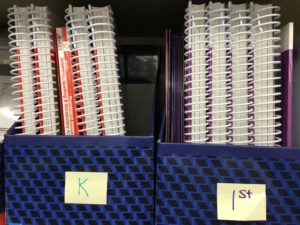
My teacher’s manuals did make it back in their display boxes with a very official sticky note label!
Bebi and I got together. We rolled out our curriculum maps and rolled up our sleeves. Then we collected ALL of the teacher’s manuals from this new curriculum in both languages, and we set about dissecting it all. The question we kept coming back to was this:
How can we use this resource to enhance any of our biliteracy units while remaining true to our reading focus, writing focus, and content/language allocation for each unit?
I wish it was a simple answer.
When we think about our biliteracy units, we know that each unit must be balanced between reading, writing, and word study, all within a meaningful context for our language learners. And, by the way, ALL of our students are language learners. Aren’t all of us – even as adults – language learners? Keep that perspective when unit planning….
One of the things I felt I was lacking as a teacher was systematic phonics within context. The resource our district adopted has claimed to provide systemic phonics instruction, so I insisted that Bebi and I look at that first.
Well… the phonics seemed systemic in English, but Spanish was just a translation. As we broke down our kindergarten phonics lessons, for example, the English lessons started with letter sounds and initial sounds of words…but so did Spanish. In the same order. We know that our children are bright. All of them. Yes, some have specific learning disabilities and some have dyslexia and some are English language learners and some are Spanish language learners. They DO NOT need to learn content twice. If letter d says /d/ in English and in Spanish, we do not need to spend a week in EACH CLASS teaching the /d/ sound. We decided that I would teach the systematic phonics in English in the order our resource suggested, and Bebi would continue to do what she has been trained is best for early Spanish literacy development, and we would be sure to Bridge at the conclusion of each unit to reinforce to our students the similarities and differences between English and Spanish.
I wish that it was a simple as “I follow the phonics progression of the resource.” It’s not that simple. Each week, the first grade curriculum suggests 8-10 spelling words, a combination of words that follow the spelling sound pattern from the phonics unit and some high frequency words. However, knowing that I teach for biliteracy and ALL (remember, ALL) of my students are Language Learners, I need to put both the phonics lessons and high frequency word in context.
A few weeks ago, for example, I was supposed to teach soft c and soft g. It was so fun to point out to my students that the sound patterns are the same for those letters between English and Spanish! They got a kick out of saying “suave!” and waving their arms when c or g was followed by i, e, or y. But the curriculum had my students practicing writing words completely out of context. I found myself having to explain what a “gent” is, for example, because it had nothing to do with our social studies unit (Reno in the Past). My heart ached as I followed the curriculum, practice words just to practice the spelling pattern and with little meaning whatsoever. What good is a word sort if you have to spend half the time explaining the vocabulary??
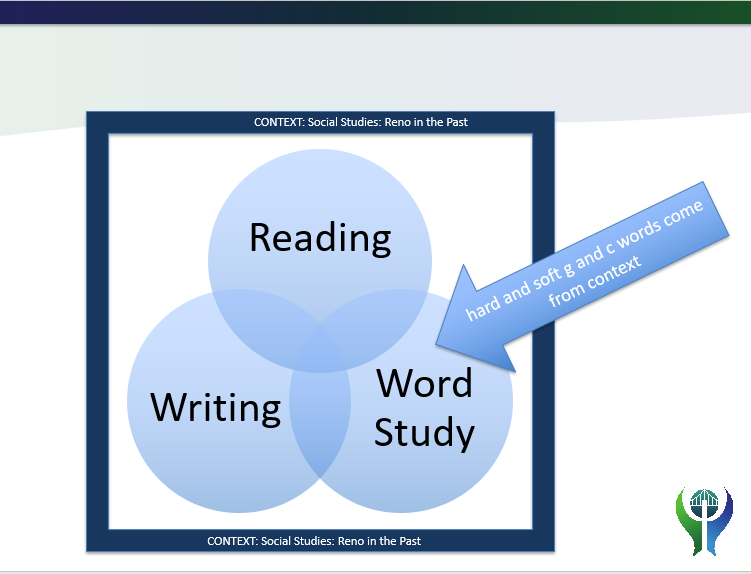
In balanced literacy, reading, writing, and word study are incorporated within a meaningful context. In my example, teaching the foundational skill of soft c and g did not work when the words were random and simply followed a spelling pattern. Instead, I needed to find MEANINGFUL words from the unit in order for my students understand the purpose of the word study and apply it.
Instead of “gent” and “cent” (the words that the resource gave as examples), my biliteracy unit has words such as “age”, “citizen”, “city”, and “place”, all of which had soft g or soft c. Some of these context-friendly words also lent to the spelling pattern of long a with silent -e, which came into play the very next week in the suggested phonics progression! And because my students are used to comparing words during the Bridge at the end of our units, they LOVE finding patterns in words and noticed silent e as well as “c suave” or “g suave” in every possible example in our TPR!
It was decided: We would NOT let the resource drive our units! I took the systemic English phonics and planned a little for each standards-based unit. Research today is showing the necessity of systematic phonics for our English readers, and because I am not a researcher myself, I have to trust the experts. I am not going to alter the system. Instead, I am going to make sure the phonics I teach my students is within context. They must have something to relate it to, otherwise it will never make sense!
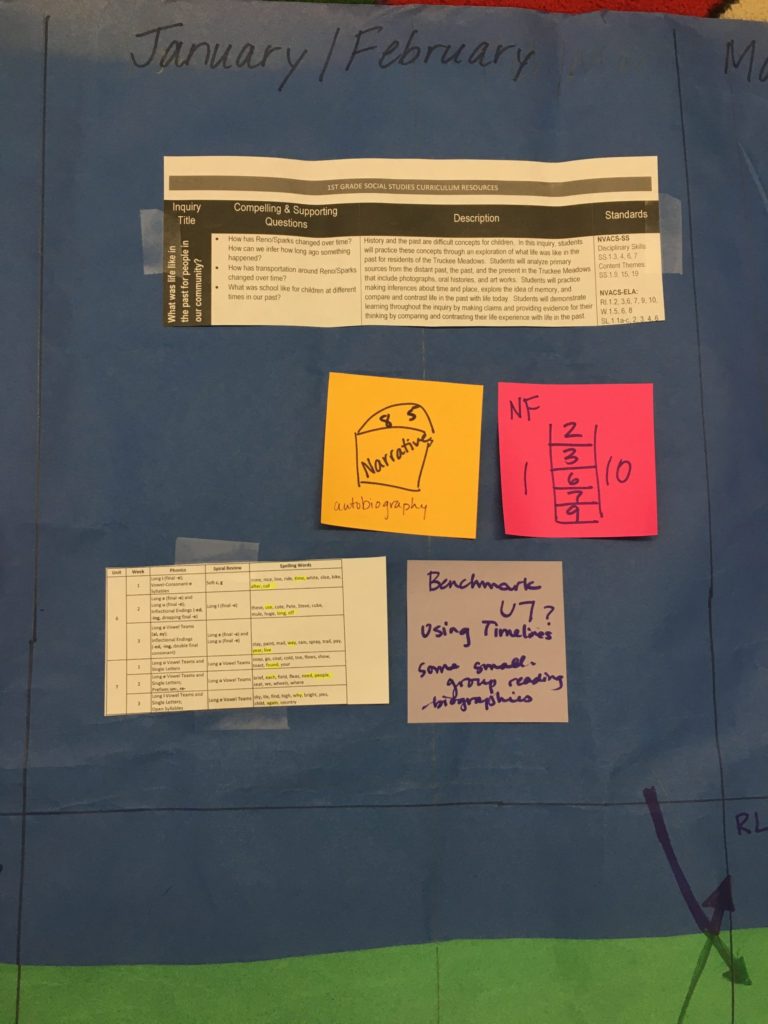
This is a picture of one section of our map I added to based off the resource materials I had available.
Once I mapped the phonics, I highlighted which spelling words and high frequency words would be appropriate with the unit, focusing on a maximum of four words. When we practice phonics, we do so with dictation/dictado. (More on that in another blog!) My students use the words in context and continuously revisit words from past units, so “only” having four spelling words a week is not doing my students a disservice.
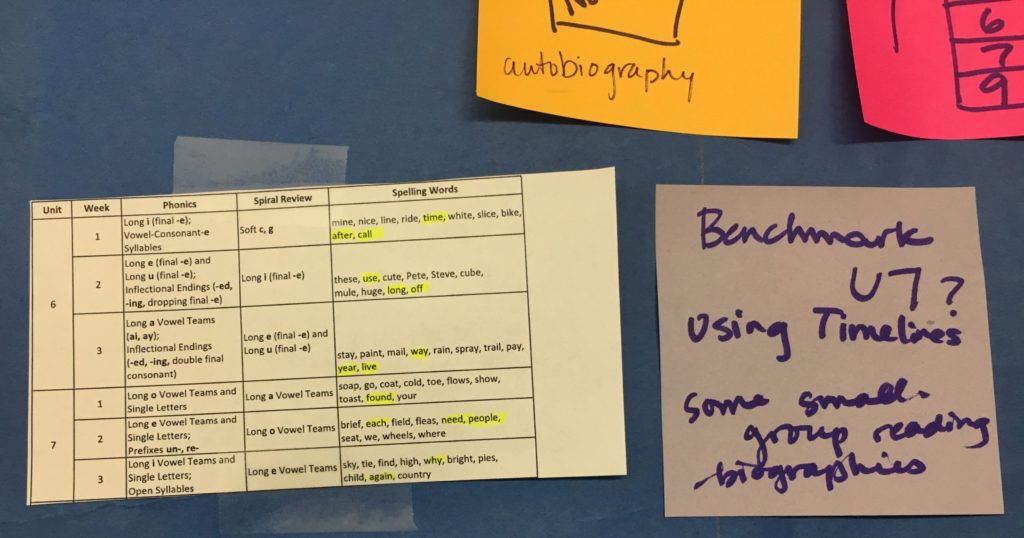
The highlighted terms are those I decided would work with both the phonics progression and the context of the social studies unit I will be teaching. There may not be four words a week yet, but that gives me the option to add other words pertinent to the unit that I may come across in texts that match the spelling pattern.
What about the rest of the resource? How else can I use it?
We found that some of the materials (read alouds, shared reads, etc.) provided with the resource aligned with some of my English units, and some of them aligned with Bebi’s Spanish units. We made notes on our map as reminders to “check out” certain units from the resource when we get to each unit. At that point, we added those extra materials as options to the appropriate portion of our Biliteracy Unit Framework, therefore beefing up our on-topic resources.
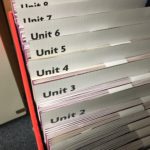 We also noted that some of the leveled texts provided with the units may be appropriate for small group instruction when the content matched our standards-based units. We wanted to be sure to remember to utilize those resources once we got to the point in the school year where they might come in handy based off the needs of our students.
We also noted that some of the leveled texts provided with the units may be appropriate for small group instruction when the content matched our standards-based units. We wanted to be sure to remember to utilize those resources once we got to the point in the school year where they might come in handy based off the needs of our students.
All in all, there were some units for which I won’t use the resources in English, because Bebi will use them in Spanish, and vise versa. And there are some units for which neither of us will use the materials, and that’s okay. Remember, a resource is just that: a resource. We planned strategically to see how we could use it to best meet the needs of our bilingual students.
But what if you don’t get the pass to use your resources as resources and rather are directed to use them with fidelity? I would encourage you to have a very frank conversation with administration about the goals of your dual language program and about what systems and structures can support achieving those goals. And share this blog and other resources on this website!
If you find yourself surrounded by boxes and swimming in new materials, congratulations! You have a bit of work ahead of you (and perhaps you’ll be storing some things you may never use), but at least you will have more resources for your biliteracy units than you did before!
Look for my next blog in April around FAQs for the English side of a dual language program. Until then, remember: We teach students, not resources!



